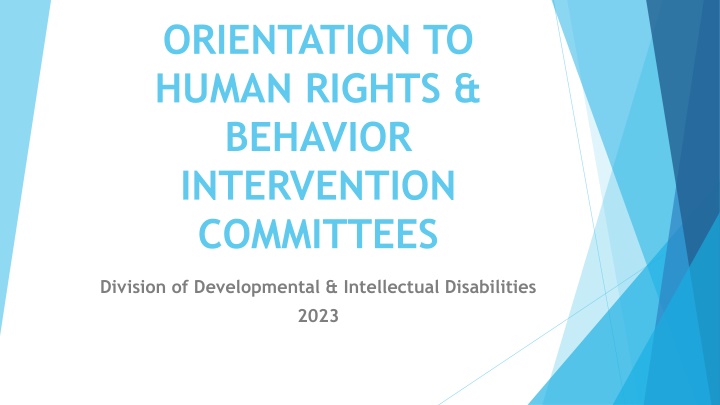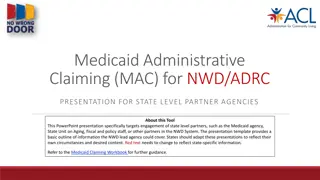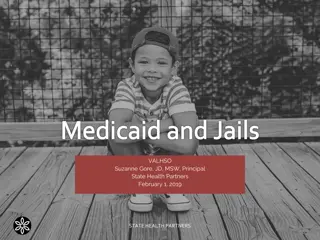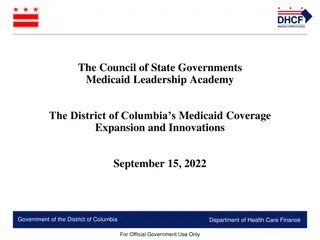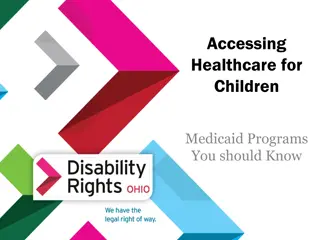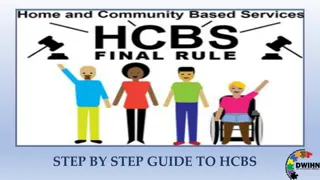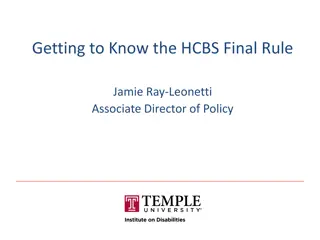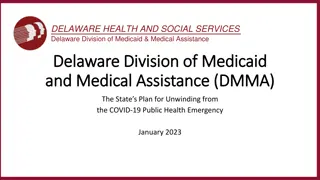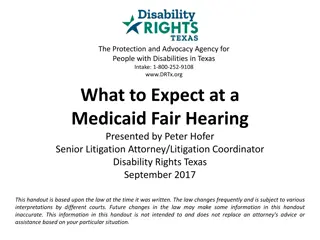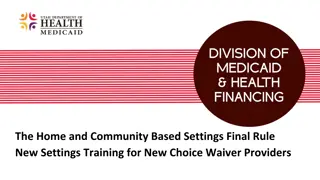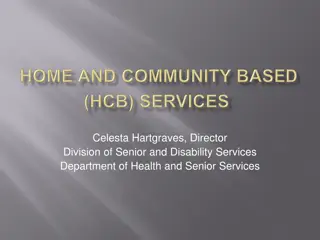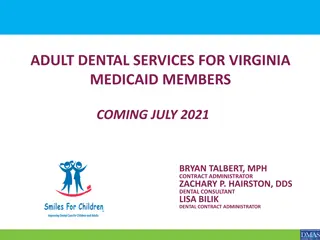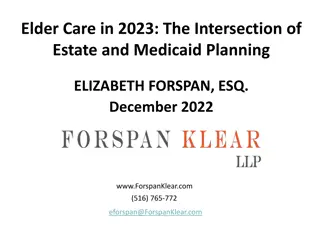Ensuring Rights and Community Living for Medicaid-funded Home-Based Services
The Home and Community Based Services Settings Rule under Medicaid ensures individuals receiving services have full access to community living benefits, including autonomy, privacy, dignity, and choice in decision-making. The rule emphasizes person-centered planning, integration with the community, individual rights, and choice of services and supports. It aims to promote independence, autonomy, and respect for individuals receiving Medicaid HCBS. Compliance with set qualities is crucial for provider-owned residential settings.
Download Presentation

Please find below an Image/Link to download the presentation.
The content on the website is provided AS IS for your information and personal use only. It may not be sold, licensed, or shared on other websites without obtaining consent from the author.If you encounter any issues during the download, it is possible that the publisher has removed the file from their server.
You are allowed to download the files provided on this website for personal or commercial use, subject to the condition that they are used lawfully. All files are the property of their respective owners.
The content on the website is provided AS IS for your information and personal use only. It may not be sold, licensed, or shared on other websites without obtaining consent from the author.
E N D
Presentation Transcript
ORIENTATION TO HUMAN RIGHTS & BEHAVIOR INTERVENTION COMMITTEES Division of Developmental & Intellectual Disabilities 2023
Joint Statement from the Centers for Medicare & Medicaid Services (CMS) and the Administration for Community Living (ACL): Implementation of the Home and Community Based Services Settings Regulation (Excerpt below, full statement can be found here: March 17, 2023 ACL-CMS Statement (medicaid.gov)) The HCBS Settings Rule was created to ensure that every person receiving Medicaid-funded HCBS has full access to the benefits of community living. It protects individuals autonomy to make choices and to control the decisions in their lives, a right most people take for granted. This includes controlling personal resources; being treated with privacy, dignity, respect, and freedom from coercion and restraint; deciding what and when to eat; having visitors; being able to lock doors; and having the protections of a lease or other legally enforceable agreement. The rule requires a person-centered process for planning HCBS, which means that the individuals receiving services direct the planning process and the plan reflects their own preferences and goals they have set for themselves.
Home and community-based settings must have all of the following qualities, and such other qualities as the Secretary determines to be appropriate, based on the needs of the individual as indicated in their person-centered service plan: (i) The setting is integrated in and supports full access of individuals receiving Medicaid HCBS to the greater community, including opportunities to seek employment and work in competitive integrated settings, engage in community life, control personal resources, and receive services in the community, to the same degree of access as individuals not receiving Medicaid HCBS. (ii) The setting is selected by the individual from among setting options including non-disability specific settings and an option for a private unit in a residential setting. The setting options are identified and documented in the person-centered service plan and are based on the individual's needs, preferences, and, for residential settings, resources available for room and board. (iii) Ensures an individual's rights of privacy, dignity and respect, and freedom from coercion and restraint. (iv) Optimizes, but does not regiment, individual initiative, autonomy, and independence in making life choices, including but not limited to, daily activities, physical environment, and with whom to interact. (v) Facilitates individual choice regarding services and supports, and who provides them.
(vi) In a provider-owned or controlled residential setting, in addition to the qualities at 441.301(c)(4)(i) through (v), the following additional conditions must be met: (A) The unit or dwelling is a specific physical place that can be owned, rented, or occupied under a legally enforceable agreement by the individual receiving services, and the individual has, at a minimum, the same responsibilities and protections from eviction that tenants have under the landlord/tenant law of the State, county, city, or other designated entity. For settings in which landlord tenant laws do not apply, the State must ensure that a lease, residency agreement or other form of written agreement will be in place for each HCBS participant, and that the document provides protections that address eviction processes and appeals comparable to those provided under the jurisdiction's landlord tenant law.
(B) Each individual has privacy in their sleeping or living unit: (1) Units have entrance doors lockable by the individual, with only appropriate staff having keys to doors. (2) Individuals sharing units have a choice of roommates in that setting. (3) Individuals have the freedom to furnish and decorate their sleeping or living units within the lease or other agreement. (C) Individuals have the freedom and support to control their own schedules and activities, and have access to food at any time. (D) Individuals are able to have visitors of their choosing at any time. (E) The setting is physically accessible to the individual.
Any modification of the listed conditions, under 441.301(c)(4)(vi)(A) through (D), must be supported by a specific assessed need and justified in the person-centered service plan. The following requirements must be documented in the person-centered service plan: (1) Identify a specific and individualized assessed need. (2) Document the positive interventions and supports used prior to any modifications to the person-centered service plan. (3) Document less intrusive methods of meeting the need that have been tried but did not work. (4) Include a clear description of the condition that is directly proportionate to the specific assessed need. (5) Include regular collection and review of data to measure the ongoing effectiveness of the modification. (6) Include established time limits for periodic reviews to determine if the modification is still necessary or can be terminated. (7) Include the informed consent of the individual * (8) Include an assurance that interventions and supports will cause no harm to the individual. *Informed consent given by the person (if they have no guardian) or by the guardian, if applicable. This consent can be rescinded at any time. Ex: Just because someone says today that they are agreeable to three cigarettes a day doesn t mean they can t change their mind tomorrow.
Important Note: Providers must ensure the setting is physically accessible to the individual. There can be no modification for this right.
Additional information related to person-centered service plan requirements and participant choice can be found in Section 5 of the SCL Regulation (907 KAR 12:010). Additional information related to person-centered service plan requirements and participant choice can be found in Section 8 of the MPW Regulation (907 KAR 1:835).
HUMAN RIGHTS COMMITTEE (HRC) A human rights committee shall meet on a routine, scheduled basis, no less than quarterly to ensure that the rights of participants utilizing SCL and MPW services are respected and protected through due process.
HUMAN RIGHTS COMMITTEE MEMBERSHIP (as defined by regulation) At least one (1) self advocate At least one (1) member from the community at large with experience in human rights issues or in the field of intellectual or developmental disabilities. At least one (1) family member or guardian of a waiver participant. One (1) professional in the medical field with a bachelor s degree and three (3) years of experience in the field of intellectual or developmental disabilities.
HUMAN RIGHTS COMMITTEE Provider Role (as defined by regulation) Actively participate in the human rights committee process of the local human rights committee Provide the necessary documentation to the local human rights committee for review and approval prior to the implementation of any rights restrictions or positive behavior support plans involving restrictions.
HUMAN RIGHTS COMMITTEE Quorum (as defined by regulation) A human rights committee meeting shall have a quorum of at least three (3) members, including at least one (1) self-advocate and one (1) community at large member.
HUMAN RIGHTS COMMITTEE Maintenance of Records Maintain a record of each meeting. Send a summary of each person-centered service plan reviewed to the relevant participant, guardian (when applicable), and case manager.
HUMAN RIGHTS COMMITTEE Requirements of Members Each member of the Human Rights committee must: Complete an orientation approved by BHDID Sign a confidentiality agreement Function in accordance with the Health Insurance Portability and Accountability Act (HIPPA)
Behavior Intervention Committee (BIC) A behavior intervention committee shall meet at least quarterly to review, approve, and as necessary, make written technical recommendations for each new or revised positive behavior support plan.
BEHAVIOR INTERVENTION COMMITTEE MEMBERSHIP (as defined by regulation) One (1) self-advocate, representative, or family member. At least one (1) member from the community at large with experience in human rights issues or in the field of intellectual or developmental disabilities. At least one of the following: A positive behavior support specialist A licensed psychologist A certified psychologist A licensed clinical social worker
BEHAVIOR INTERVENTION COMMITTEE Quorum (as defined by regulation) A behavior intervention committee meeting shall have a quorum of at least three (3) members including: Self-advocate, representative, or family member Member from the community at large with experience in human rights issues or the field of intellectual or developmental disabilities
BEHAVIOR INTERVENTION COMMITTEE Responsibilities (as defined by regulation) A behavior intervention committee shall ensure that: Positive behavior supports are clinically sound and based on the person-centered values considering what is important for the participant. Assessments and interventions utilize evidence based and best practices for treatment of a behavioral health condition as the primary support when supplemental behavioral interventions are needed. The use of BOTH behavioral health treatment and positive behavioral supports shall be utilized in a collaborative manner.
BEHAVIOR INTERVENTION COMMITTEE Responsibilities Continued A new or revised positive behavior support plan is not implemented until it is approved by: The behavior intervention committee If rights restrictions are recommended, the human rights committee
BEHAVIOR INTERVENTION COMMITTEE Maintenance of Records Maintain a record of each meeting. Send a summary of each person-centered service plan reviewed to the relevant participant, guardian (when applicable), and case manager.
BEHAVIOR INTERVENTION COMMITTEE Requirements of Members Each member of the behavior intervention committee must: Complete an orientation approved by BHDID Sign a confidentiality agreement Function in accordance with the Health Insurance Portability and Accountability Act (HIPPA)
Final Orientation Information HRC/BIC Resources: Orientation PowerPoint Sample Certificate of Completion Sample Confidentiality Agreement http://dbhdid.ky.gov/ddid/hrcbic.aspx
